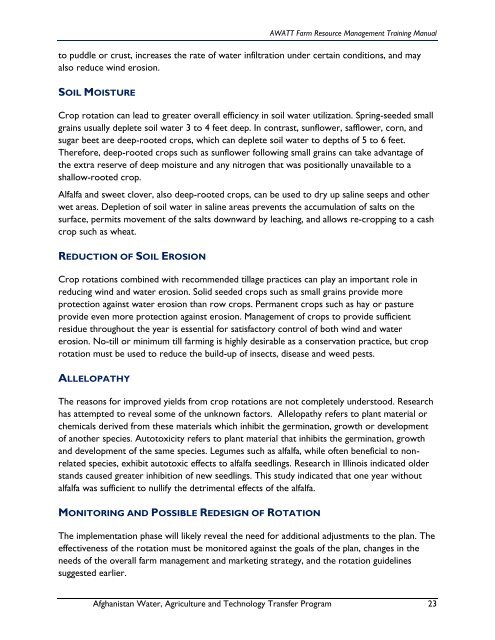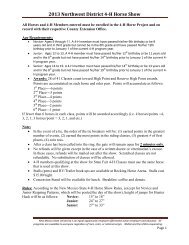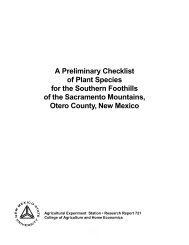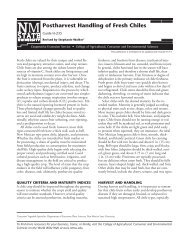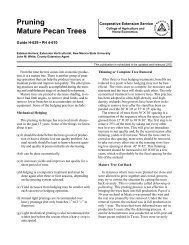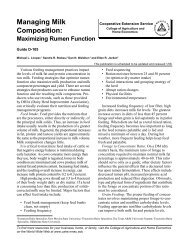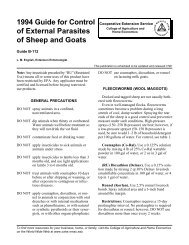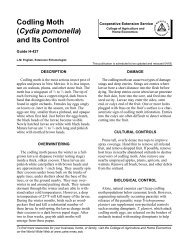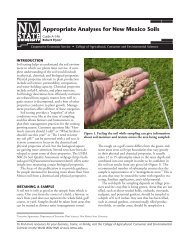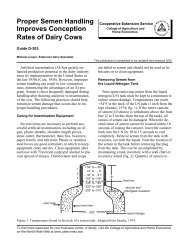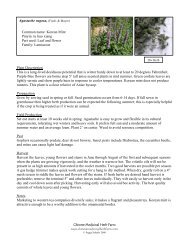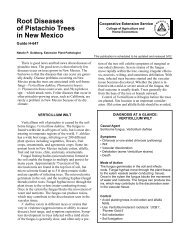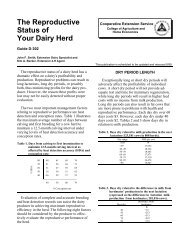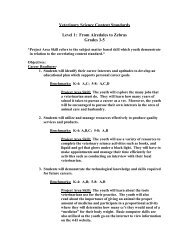Farm Resource Management (FRM) - College of Agricultural ...
Farm Resource Management (FRM) - College of Agricultural ...
Farm Resource Management (FRM) - College of Agricultural ...
Create successful ePaper yourself
Turn your PDF publications into a flip-book with our unique Google optimized e-Paper software.
AWATT <strong>Farm</strong> <strong>Resource</strong> <strong>Management</strong> Training Manualto puddle or crust, increases the rate <strong>of</strong> water infiltration under certain conditions, and mayalso reduce wind erosion.SOIL MOISTURECrop rotation can lead to greater overall efficiency in soil water utilization. Spring-seeded smallgrains usually deplete soil water 3 to 4 feet deep. In contrast, sunflower, safflower, corn, andsugar beet are deep-rooted crops, which can deplete soil water to depths <strong>of</strong> 5 to 6 feet.Therefore, deep-rooted crops such as sunflower following small grains can take advantage <strong>of</strong>the extra reserve <strong>of</strong> deep moisture and any nitrogen that was positionally unavailable to ashallow-rooted crop.Alfalfa and sweet clover, also deep-rooted crops, can be used to dry up saline seeps and otherwet areas. Depletion <strong>of</strong> soil water in saline areas prevents the accumulation <strong>of</strong> salts on thesurface, permits movement <strong>of</strong> the salts downward by leaching, and allows re-cropping to a cashcrop such as wheat.REDUCTION OF SOIL EROSIONCrop rotations combined with recommended tillage practices can play an important role inreducing wind and water erosion. Solid seeded crops such as small grains provide moreprotection against water erosion than row crops. Permanent crops such as hay or pastureprovide even more protection against erosion. <strong>Management</strong> <strong>of</strong> crops to provide sufficientresidue throughout the year is essential for satisfactory control <strong>of</strong> both wind and watererosion. No-till or minimum till farming is highly desirable as a conservation practice, but croprotation must be used to reduce the build-up <strong>of</strong> insects, disease and weed pests.ALLELOPATHYThe reasons for improved yields from crop rotations are not completely understood. Researchhas attempted to reveal some <strong>of</strong> the unknown factors. Allelopathy refers to plant material orchemicals derived from these materials which inhibit the germination, growth or development<strong>of</strong> another species. Autotoxicity refers to plant material that inhibits the germination, growthand development <strong>of</strong> the same species. Legumes such as alfalfa, while <strong>of</strong>ten beneficial to nonrelatedspecies, exhibit autotoxic effects to alfalfa seedlings. Research in Illinois indicated olderstands caused greater inhibition <strong>of</strong> new seedlings. This study indicated that one year withoutalfalfa was sufficient to nullify the detrimental effects <strong>of</strong> the alfalfa.MONITORING AND POSSIBLE REDESIGN OF ROTATIONThe implementation phase will likely reveal the need for additional adjustments to the plan. Theeffectiveness <strong>of</strong> the rotation must be monitored against the goals <strong>of</strong> the plan, changes in theneeds <strong>of</strong> the overall farm management and marketing strategy, and the rotation guidelinessuggested earlier.Afghanistan Water, Agriculture and Technology Transfer Program 23


